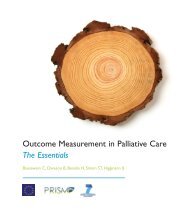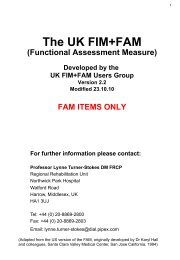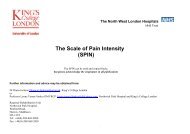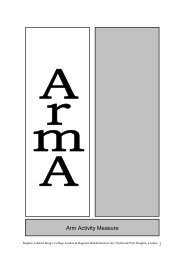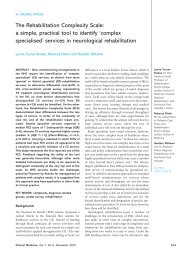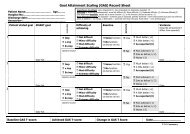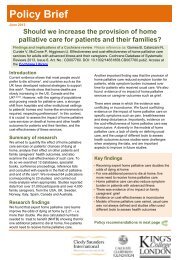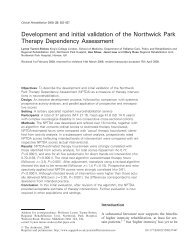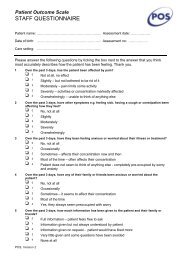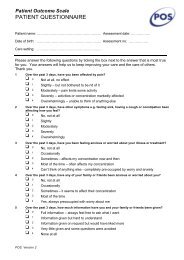2004 - 2007 - Cicely Saunders Institute - King's College London
2004 - 2007 - Cicely Saunders Institute - King's College London
2004 - 2007 - Cicely Saunders Institute - King's College London
You also want an ePaper? Increase the reach of your titles
YUMPU automatically turns print PDFs into web optimized ePapers that Google loves.
ICP for assessment and management<br />
of hemiplegic shoulder pain:<br />
• The ShoulderQ, which we have developed to assess<br />
shoulder pain in this context, was shown to provide a<br />
specific and sensitive assessment of response to<br />
treatment 252 .<br />
• The Scale of Pain Intensity (SPIN) was developed as<br />
a simple and accessible tool for assessing pain in<br />
people who are unable to complete the ShoulderQ.<br />
Preliminary evaluation suggests that it has potential<br />
for use in this context, and further evaluation is now<br />
underway 234 . (see In Focus 2.2)<br />
ICP for assessment and management of<br />
depression:<br />
• National clinical guidelines on the assessment and<br />
management of depression in patients following<br />
stroke and acquired brain injury have been modelled<br />
on the ICP 189 .<br />
ICP for the management of spasticity<br />
• Our on-going evaluation of the functional benefits of<br />
botulinum toxin in the management of spasticity was<br />
a significant factor in the successful achievement of<br />
a UK licence for its use in the management of upper<br />
limb spasticity 5 .<br />
• Our first successful use of goal attainment scaling<br />
(GAS) to measure meaningful change in this context<br />
is now being taken up in other studies 209 .<br />
• The Depression Intensity Scale Circles (DISCs) is an<br />
equivalent scale to the SPIN. Evaluation using the ICP<br />
showed it to provide a valid and reliable assessment<br />
of depression in the context of brain injury<br />
(see In Focus) 164 .<br />
In focus 2.2<br />
Assessment Of Pain & Depression<br />
Assessing symptoms in people with cognitive<br />
and communication problems:<br />
A novel approach to a difficult problem<br />
Assessing symptoms is essential for the successful<br />
management of medical conditions. However, people<br />
with cognitive or communication problems, for example<br />
due to acquired brain injury, confusion or other severe<br />
illness, may have difficulty in using traditional measures.<br />
As visual cues may help communication, we have<br />
developed and evaluated a pictorial measure that can<br />
help patients report on their symptoms.<br />
This work has been carried out in the context of<br />
developing Integrated Care Pathways (ICPs) for the<br />
management of depression and pain respectively, in<br />
which regular symptom assessment plays an integral part.<br />
The Depression Intensity Scale Circles (DISCs)<br />
The concept of increasing depression is represented by<br />
a sequence of five dark grey circles increasing in size.<br />
The mode of administration is adapted to suit the<br />
individual’s cognitive and communicative abilities. Their<br />
ability to make reliable ‘yes/no’ responses is established<br />
using a screening questionnaire, the AbilityQ, and is<br />
followed by a verbal explanation of the scale reinforced<br />
by gesture or pictures as appropriate.<br />
The DISCs has been shown to have acceptable<br />
convergent validity, reliability and responsiveness as a<br />
simple graded tool for the screening and assessment of<br />
depression in patients with complex disabilities following<br />
acquired brain injury and is now one of the<br />
recommended tools for assessing depression in the<br />
Royal <strong>College</strong> of Physicians guidelines for depression<br />
following brain injury 164 .<br />
The Scale of Pain Intensity (SPIN)<br />
The SPIN uses the same idea as the DISCs, except that<br />
the circles are coloured red to convey the concept of<br />
pain. To reinforce its meaning, the colour red is also<br />
used on separate body drawings to indicate the region<br />
of the body where pain may be a problem.<br />
A preliminary study to validate<br />
the SPIN in a general<br />
population with pain has<br />
found that it could quantify<br />
pain as well as the current<br />
preferred tool, a 0-10 numeric<br />
rating scale. Subsequent<br />
observation of verbal and<br />
non-verbal interaction<br />
between speech and<br />
language therapists and<br />
patients with severe<br />
dysphasia, together with the<br />
experience of clinicians in<br />
using the SPIN, has informed<br />
its administration 280;234 . This<br />
tool is now an integral part of<br />
the multidisciplinary ICP for<br />
managing shoulder pain in<br />
stroke patients in daily use on<br />
our regional rehabilitation unit.<br />
Figure 2.7 The Depression<br />
Intensity Scale Circles (DISCs)<br />
Most severe<br />
Depression<br />
No Depression<br />
14<br />
14





